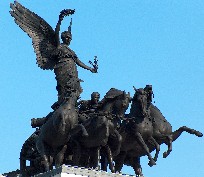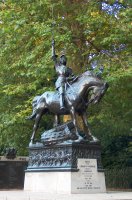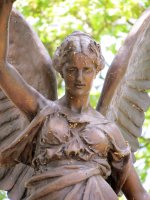Adrian Jones (1845-1938)
Peace in her Quadriga.
The sculptor Adrian Jones is best known for the Quadriga on top of the arch at Hyde Park Corner, and other equestrian works.
It is extremely likely that no modeller of a horse has more inimate knowledge of his subject than [Adrian Jones], who has served professionally in India, and through the Abyssinian, Boer, and Nile wars of 1868, 1879, and 1884. As veterinary surgeon to the 3rd Hussars, Queen's Bays, and 2nd Life Guards he probably had better opportunities of studying every class of horse, from the highest downwards, than has fallen to the lot of almost any other man in England."
Adrian Jones is an interesting sculptor, specialising in equestrian figures, with an unconventional career. He was born in Ludlow, Shropshire, studied at the Royal Veterinary College, qualifying in 1866 as a vetinary surgeon, and enrolling in the Army as a veterinary officer in the Royal Horse Artillery the following year. It was only in 1890, having achieved the rank of captain, that he retired, and in 1891 set himself up in Chelsea as an artist. He had little formal art training, working for a time under C. B. Birch, but prospered with commissions for horse portraits.
Cavalry monument.
His most important - indeed, spectacular - work is the 40-ton Peace in her Quadriga (i.e. four-horsed chariot), dating from 1912 and emplaced on top of the Arch at Hyde Park Corner. An excellent St George slaying an equally excellent crocodile-like dragon (Cavalry Monument) is also in Hyde Park, see picture above (click to enlarge). Also in London, he has the George, Duke of Cambridge in Whitehall, and the (non-equestrian) Marines Memorial on The Mall. On Chelsea Embankment opposite the bridge is a horsey plaque for a Boer War Memorial, and a plaster version of this is in the National Army Museum near Sloane Square. Outside London, we may mention General Sir Rodgers Buller in Exeter, the Royal Gloucester Hussars Monument in Gloucester (see this page), and a plaque to Charles Berkeley Pigott in Winchester Cathedral.


